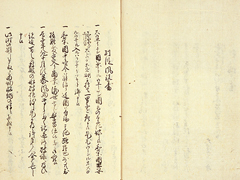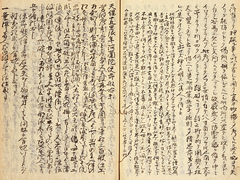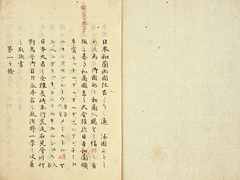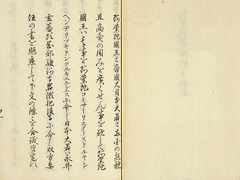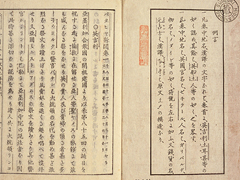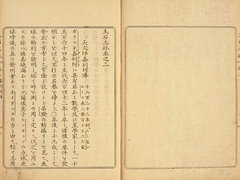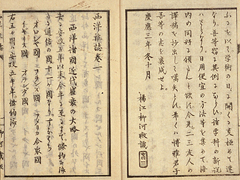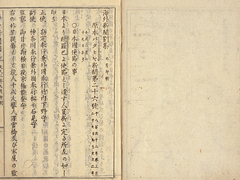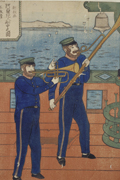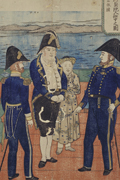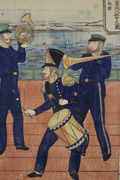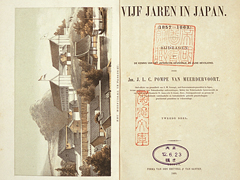Home | Part 1: Tracing the History | 4. Opening of Japan and Japan-Netherlands Relations
Part 1: Tracing the History
4. Opening of Japan and Japan-Netherlands Relations
(1) Encroachment of Europe and America
In 1839, the First Opium War broke out between Qing China and Great Britain and this alerted Japan to the possibility of invasion by Western European countries. Around this time Fusetsu gaki (News Reports) were standardized and simplified and in addition to these, Betsudan fusetsu gaki (Separate Reports) providing detailed information on the Opium War began to be submitted from 1840. These detailed reports on foreign affairs were continued even after the end of the Opium War.
Nagasaki Ward Elder Takashima Shuhan espoused the need to introduce Western cannon technology as soon as possible, and in time the Shogunate government also became interested in this. In 1842, the Order to Drive Away the Foreign Ships, which called for foreign ships to be driven away irrespective of the reason for their arrival, was relaxed to allow foreign ships that ran aground to be supplied with food and water before being sent away. The Shogunate government also commissioned communiques to be passed to Western countries through the Dutch factory (this was done in 1847).
When these actions came to the attention of Willem II, King of the Netherlands, he advised the Shogunate government that now would be a good opportunity to open the country. It is thought that the advice of P. F. von Siebold was behind this as well. The Dutch ambassador made port in Nagasaki in 1844 bearing a message and gifts from the King. The Shogunate government turned down this advice, but the number of ships from Europe and America appearing in waters close to Japan kept increasing.
(2) Opening of the Country
Under these circumstances, the U.S. East India Fleet commanded by Commodore M. C. Perry was dispatched to open Japan. The Netherlands aimed to use this as an opportunity to form a new treaty with Japan. This mission was given to the last chief of the Dutch factory J. H. Donker Curtius who assumed his post in 1852 and warned that the American ambassador was sailing to Japan. The Shogunate government took no special response, however, and when the U.S. fleet arrived at Uraga in 1853, the government begged for a one-year delay and sent the fleet away. When the fleet returned the next year (1854), M. C. Perry's hard-line approach resulted in the formation of the U.S.-Japan Treaty of Peace and Amity, and Japan opened Shimoda and Hakodate. Following this, Japan also formed treaties with Great Britain and Russia. This marked the end of the 'Closed Country' policy that had continued for over 200 years.
The Shogunate government became urgently aware of the need to strengthen its naval capability, and in 1853 ordered a warship to the Netherlands that until then had been the only Western country with which it had relations. The next year, the warship Soembing arrived in Nagasaki and naval training for Japanese was provided over a short three-month period by the captain, Commander G. Fabius. This ship was presented to the Shogunate government in 1855, rechristened as Kanko-maru, and became the government's second naval training ship. At this time, 22 naval seamen including Lieutenant junior G. C. C. Pels Rijken provided training, and this training was continued by Lieutenant H. van Kattendijke who arrived in Japan on the Japan (Kanrin-maru). After a change of policy by the Shogunate government, the Navy Officer Training School in Nagasaki was closed in 1859, but this was the first time that Japanese had received organized direct training from the Dutch. (II-5)
The Dutch-Japan Treaty of Peace and Amity was concluded by J. H. Donker Curtius in Nagasaki in January 1856. From this time onward, people were allowed to freely enter and leave Deshima, but trade was still controlled by the Nagasaki accounting office.
The Additional Dutch-Japan Treaty was signed in October 1857. This was the first trade agreement concluded between Japan and a foreign country, and it relaxed the restriction of trading at Deshima to also allow trading at Hakodate. When T. Harris concluded the U.S.-Japan Treaty of Amity and Commerce in 1858, the Natherlands also hurried to conclude a new trade treaty, and one month later the Dutch-Japan Treaty of Amity and Commerce with almost the same provisions as the U.S.-Japan Treaty of Amity and Commerce was concluded. This greatly changed the form of trade between the Netherlands and Japan from trade with the accounting office handled solely by the Dutch factory to free trade handled by individual merchants.
The resident organization in Japan representing the Netherlands also changed from the Dutch factory to the Consulate. The first Consul to Japan, J. K. de Wit, took up his post in February 1860. The Consulate General was still on Deshima, but Nagasaki had already lost its position as the sole trading port.
(3) Subsequent Japan-Netherlands Relations
The Shogunate government formally established the Bureau for the Inspection of Barbarian Books in 1856 to research Western studies and translate Western books. As denoted by the naming of this organization as the Bureau for Western Studies, from the planning stage, the intent was to broaden education from Dutch studies where just the Dutch language was learned, to Western studies reflecting the increasing necessity of learning other languages like English and French after the opening of the country. The Bureau for the Inspection of Barbarian Books employed many Western studies scholars, and translation and research shifted from the natural sciences, which had previously been prominent, to the study of such fields as politics and law. The Bureau for the Inspection of Barbarian Books was renamed the Bureau for the Inspection of Western Books in 1862, and the next year (1863) became Kaiseijo - one of the forerunner of what became the University of Tokyo after the Meiji Restoration.
(Column: Dutch Books Belonged to the Shogunate Government)
With the opening of the country, the submission of the Dutch News Reports by the chief of the Dutch factory stopped in 1859. But the need to learn of foreign circumstances focusing on Europe and America remained, so the Shogunate government translated and printed its own foreign news reports. These were called the Kanpan Batabiya Shinbun (Official Batavian newspaper).
In addition, it was urgent for the government to acquire the advanced military technology of Europe and America to counter their incursion into Japan. The Netherlands no longer held its former international position in the face of more powerful countries like Great Britain and France, but it was still more convenient to acquire military knowledge from the Dutch language. Naval training was conducted by Dutch naval personnel and many Dutch language military academy textbooks and other books were imported and used. (II-5)
In 1862, the Shogunate government sent students to the Netherlands to study naval technology. Sixteen brilliant people (one of artisans remained behind in Nagasaki due to illness), including Enomoto Takeaki, Nishi Amane and Tsuda Mamichi, were sent and studied shipbuilding, navigation, medicine, law and other fields. After the Meiji Restoration, Nishi and Tsuda became pioneers in the introduction of philosophy, law and other fields. (II-6)
In addition, the delegation sent from the Shogunate government to Europe also visited the Netherlands in 1862 and was exuberantly welcomed. It was very significant for many Japanese, including Fukuchi Gen'ichiro (Fukuchi Ochi) and Fukuzawa Yukichi, to see the things and systems in European countries.
In 1863, the Consulate General was moved from Nagasaki to Edo. The Dutch government needed to keep pace with other countries to counter the vigorous anti-foreigner movement and protect powerful interests, and so a Dutch warship participated in the bombardment of Shimonoseki by the joint four-country naval forces the following year.
-
Nagasaki woodblock print showing Dutch office playing music onboard ship
Orandajin senchu no zu.
(4) The End of Dutch Studies
After the opening of the country, the trend shifted to the acquisition of Western learning and technology directly via the languages of other countries, such as Great Britain, France, America, and Germany, but due to the former tradition there were many people who understood Dutch, so knowledge still continued to be acquired from Dutch books, and Dutchmen were employed, such as doctors J. L. C. Pompe van Meerdervoort, A. F. Bauduin, and K. W. Gratama. J. L. C. Pompe van Meerdervoort established the first Western-style hospital in Japan at Nagasaki, and A. F. Bauduin who succeeded him taught medicine. K. W. Gratama instructed in chemistry in Nagasaki and after the Meiji Restoration headed the Osaka Seimikyoku (college of physics and chemistry). P. F. von Siebold also returned to Japan to make recommendations to the Shogunate government.
The superior hydraulic civil engineering and other technologies of the Netherlands remained important after the Meiji Restoration, and engineers such as C. J. van Doorn, J. de Rijke and G. A. Escher contributed as foreign employees in Japan. In addition, the people who had studied Western studies in Shogunate government organizations and Dutch learning schools were used by the Meiji government or contributed to the advancement of Western sciences and technologies as independent educators or writers.
In this way, the age of Dutch Studies ended and was replaced by Western studies during the period from the opening of the country to the Meiji Restoration. However, the Netherlands was the only Western country with which Japan had relations during the Edo period, and the acquisition of Western scholarship, knowledge, and foreign information through the Dutch language and Dutchmen served as the foundation for modernization and preparation for the Westernization of Japan.
Navigation
-

-
Beginning of Exchange
between Japan and the
Netherlands - Dutch Factory on Deshima
- Boom in Dutch Studies
-
Opening of Japan and
Japan-Netherlands
Relation - Columns
-
Beginning of Exchange
-

Copyright © 2009 National Diet Library. Japan. All Rights Reserved

